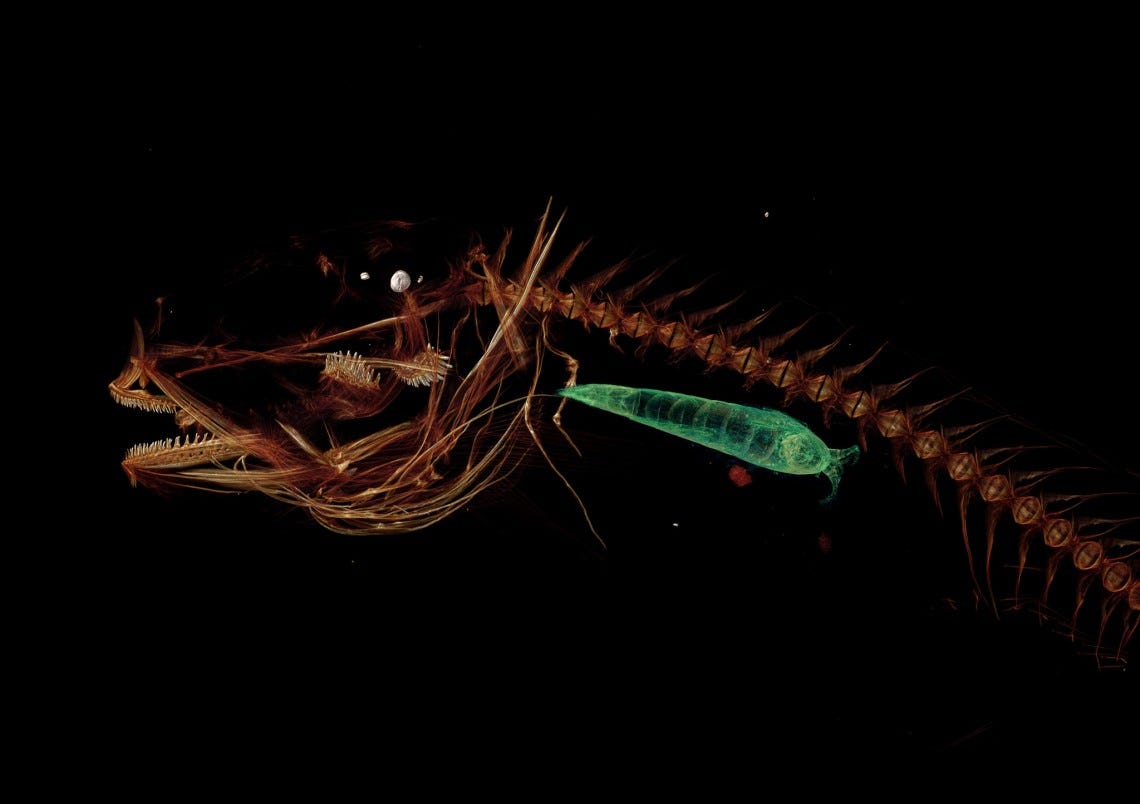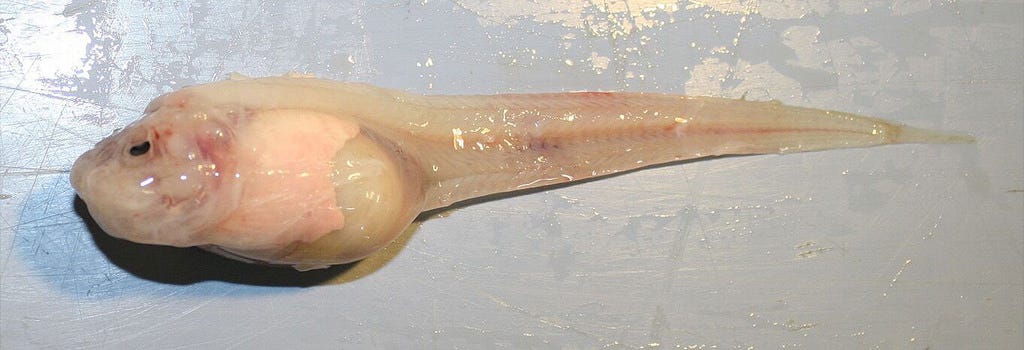When I think of deep-sea fishes, which, I admit, is not often, I think of anglerfish dangling bioluminescent lures in total darkness, or viperfish with gigantic gaping mouths and monstrous teeth. With such vicious-looking competition, you may be surprised that the current world record holder for the deepest-dwelling fish is a small (roughly, four to eight inches), pink, translucent, scale-less, tadpole-shaped fish named Pseudoliparis swirei that aggregates in groups and feeds on crustacea and shrimp.
A CT scan of the Mariana snailfish, Pseudoliparis swirei, side view. The green shape, a small crustacean, is seen in the snailfish’s stomach. Source: Adam Summers/University of Washington, with permission of Dr. Mackenzie Gerringer.
The hadopelagic or hadal zone is comprised of the deepest parts of the oceans; waters of deep-sea trenches. The name of the zone, of course, honors Hades, the Greek god of the underworld. And for most fish, finding yourself in this zone would literally be, temperature aside, hell on earth. Dr. Mackenzie Gerringer, lead author of the paper describing this record-breaking species in 2017, put life in the hadel zone in terms anyone can appreciate. In her words: “Pressure is as high as 15,000 pounds per square inch — equivalent to a large elephant standing on your thumb, and 1,100 times greater than atmospheric pressure at sea level.”
Fishes capable of surviving at such great depths must be specially adapted, even at the molecular level. They have the molecule trimethyl-amine oxide that stabilizes proteins under severe pressure and enzymes enabling their muscles to function.
Deep sea trenches form at subduction zones, stretches where one tectonic plate is sliding underneath another, and can be 20,000 to 36,000 feet deep. This creates a uniquely challenging habitat under the weight of six to seven miles of water. Specimens of Pseudoliparis swirei were collected in the deepest of all oceanic trenches, the Mariana. The fish were recovered from depths of 6898 to 7966 meters (that is over 26,000 feet!). Individuals attributed to this species were also recorded on video by a Japanese expedition even deeper, at 8178 meters! 8200 meters is believed to be the absolute maximum depth at which survival is physiologically possible. So this fish is pushing the very limits of existence.
It belongs to the family Liparidae, commonly known as snailfish. Liparids are found in temperate to cold ocean waters from pole to pole and occupy the greatest range of ocean depths of any family of fishes, from intertidal zones to this record in the hadel zone. It also has more species in the Antarctic region than any other family. About four hundred species of snailfish have been named so far, but many remain undescribed. And with habitats like the deepest chasms on the ocean floor, it is no wonder.
A specimen of the new species, Psedoliparis swirei. Source: Mackenzie Gerringer/University of Washington, University of Hawai'i
Like all world records, there are wan-a-be contenders vying for the title. Other reports of fish also collected at impressive depths exist, but they involved trap designs that did not preclude the possibility of capturing fish at shallower depths as the contraption was raised. As things stand, based on both collections made at known depths and video evidence, this little fish is the undisputed record holder.
The specific epithet honors navigational sub-lieutenant Herbert Swire, who was an officer aboard the HMS Challenger in the 1870s that found many new species and led to the discovery of the Mariana Trench. Located in the western Pacific, about 124 miles east of the Mariana Islands, the trench is 43 miles wide and more than 1500 miles long, with a maximum documented depth of more than 36,000 feet. To contextualize this astonishing number, were Mount Everest picked up and plopped onto the bottom of the Mariana trench, its summit would still stand under more than a mile of water!
The previous record was a short-lived one, standing for less than a decade. Set in 2008 by another species of the same genus, Psudoliparis amblystomopsis, it established the depth of 7,700 meters in the Japan Trench. Living so close to what seems to be a limit, whether Pseudoliparis swirei will ever be dethroned is, like all records, an open question. One that further deep-sea fish expeditions will have to answer.
Space exploration pushes the limits technology and innovation only incrementally more than expeditions to the most extreme places on earth, like the Mariana Trench, accounting for the very few surveys and limited knowledge of the creatures living there. Collecting the fish, and recording videos, were possible using lander technology developed by Dr. Alan Jamieson of Newcastle University, also part of the team discovering the fish. It takes four hours for weights to drag the lander to the bottom of the trench. Later, a signal causes this ballast to be released and the lander floats to the surface.
I don’t know about you, but I’m deeply impressed by the lander and even more so by this record breaking fish.
Further Reading
Gerringer, Mackenzie (2018) The deepest-dwelling fish in the sea is small, pink and delicate. The Conversation, 1 February.
Gerringer, M. E., Linley, T. D., Jamieson, A. J., Goetze, E., and J. C. Drazen (2017) Pseudoliparis swirei sp. nov.: A newly-discovered hadal snailfish (Scorpaeniformes: Liparidae) from the Mariana Trench. Zootaxa 4358: 161-177.



